You’ll find links to the other chapters at the bottom.
What gets measured gets done
Once you’ve set your goals as discussed in the previous post, you have to find a way to measure them. If you can’t track your goals, there is no way of telling if you’re reaching them and which parts of your campaigns are profitable and which parts aren’t.
In this post, I’ll go into measurement best practices, which will mostly be based on AdWords conversion tracking and Google Analytics.
You may use another analytics tool, and there are many great tools out there, especially enterprise analytics platforms, but when it comes to integration with AdWords, Google Analytics has some unique features:
- No need for manual tagging of your URL’s to get all campaign data into Analytics by using auto-tagging.
- Show Analytics engagement metrics like bounce rate and visit duration right within the AdWords interface. You can even create AdWords filters and automated rules based on these metrics.
- Create remarketing audiences based on Google Analytics dimensions and metrics, more about this in a future audiences post.
- Import your Analytics goals or e-commerce transactions in AdWords, although I’d recommend using AdWords conversion tracking within AdWords whenever possible, as this also enables view-through and cross-device conversions, which are not available when importing Google Analytics goals or transactions.
- Seeing AdWords data in other reports such as Multi-Channel Funnels.
To enjoy all these features, your AdWords and Analytics accounts need to be linked. So even if you use another Analytics tool, it’s worth installing Google Analytics alongside as it’s free and you get the extra features mentioned above.
If you want to learn more about how AdWords and Analytics work together (and how their reports are different) I’d recommend watching the Combined Power of AdWords and Analytics webinar, it’s an oldie from 2013, but the content is still relevant.
How to check your current conversion tracking
To check how your account is currently tracking conversions, click the tool icon in the upper right corner, and under “Measurement,” click “Conversions”.
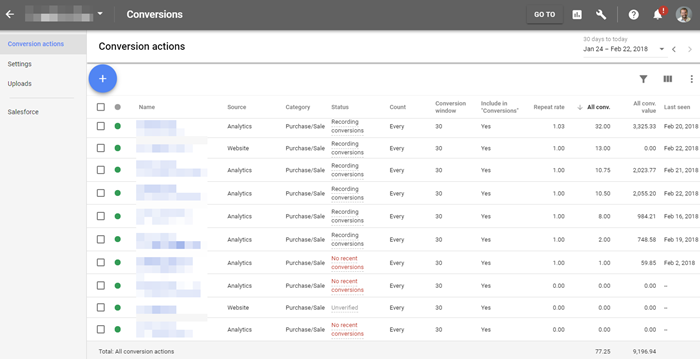
This will show you which conversions AdWords is tracking, the source, category, status and many other interesting stats.
So when looking at this screen, check for the following:
- If this screen is empty, you’ll need to set up conversion tracking as soon as possible!
- If you see a warning like ‘No recent conversions’, you need to make sure whether it’s because of the conversion script has not been placed (correctly) on the thank you page or because of the fact that the account just simply didn’t generate any recent conversions.
- Does the list of conversions look complete to you, including macro as well as micro conversions? Visit the website to get an idea of the valuable actions visitors could perform.
- Does every conversion have a value that corresponds as closely as possible with the (eventual) revenue it’s generating? In case of e-commerce, this revenue should come directly from the shopping cart system. Divide the ‘All conv. value’ by the ‘All conv.’ column to check if the value per conversion makes sense.
- Make sure there are no goals imported from Analytics that are also tracked by AdWords conversion tracking, this will mess up your conversion data.
Options for tracking website conversions
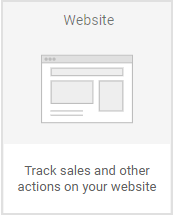
Need for cross-account conversion tracking?
In case you have Manager account (previously known as MCC) with multiple accounts all advertising for the same website and/or trying to achieve the same goals, I’d recommend using the cross-account conversion tracking.
One of the main benefits is that you’ll more accurately track the generated conversions. The drawback of account-specific conversion tracking is that you’ll risk counting the same conversion more than once when a user clicks on ads from different accounts before converting. Each account will count this conversion as long as it happened within 30 days after the click (or another conversion window if this was customized).
Determine your conversion window
The default conversion window of AdWords is 30 days after the last ad click. But you can set your conversion window anywhere from 1 to 90 days.
To find out what window is best for your account, you can check the time lag report in the attribution reports or by using the ‘days to conversion’ segment.
Measuring a fixed (assigned) value conversion with AdWords conversion tracking
For all non e-commerce conversions that result in a thank you page (like filling in a form), you can simply create an AdWords conversion and set the value to an amount that best reflects the eventual revenue from that conversion.
Measuring variable e-commerce revenue with AdWords conversion tracking
This is similar to tracking fixed value conversions, with one important difference. You’ll need to edit the code snippet as described in the ‘track transaction-specific values’ part by inserting the variable from your shopping cart system to get the revenue into AdWords.
If you don’t know what this variable looks like, contact your shopping cart provider and ask what variable is used for the total cost of goods (excluding taxes and shipping).
Measuring Events with Google Analytics
Not all conversions lead to a thank you page. For example downloads, outbound links, likes, shares, clicking on ‘add to cart’ (but not checking out), live chat and video plays could be valuable actions you’ll want to track.
AdWords conversion tracking can’t help you track this kind of interactions, but Google Analytics event tracking can. If you have Google Tag Manager, you can use its auto-event tracking functionality, so you don’t need to add custom JavaScript code to your website to track these events.
This great guide by KlientBoost will walk you through each step of event tracking.
If you use such events as goals you can import these goals into AdWords and then you’ll measure these special clicks as conversions.
Measuring phone calls

- Calls directly from ads, resulting from call extensions and call-only ads.
- Calls to a phone number on your website, using Google forwarding numbers. These forwarding numbers aren’t available in all countries though, scroll down on this page to see a list of countries where you can use Google forwarding numbers.
- Clicks on a number on your mobile website, which can easily be tracked by following these instructions.
- Third party call tracking solutions. If Google forwarding numbers aren’t available in your country or you want more call tracking options like lead scoring and supporting other channels than AdWords, you should consider using a third-party call tracking solution.
You can find many vendors at Google Analytics Call Tracking Partners overview, an extensive analysis of 12 selected vendors in Enterprise Call Analytics Platforms: A Marketer’s Guide and reviews of call tracking software at G2 Crowd.
Measuring app installs and in-app actions
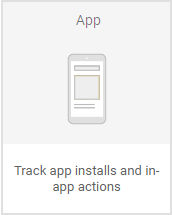
If you only care about tracking Android conversions, you can also track app conversions with Google Play.
Measuring the quality of your leads
If the goal of your campaigns is to generate leads it is important to realize that leads have no intrinsic value. Of course, your leads have an average value you’re probably using to calculate your CPA. But the percentage of these leads that actually converts to customers differs per marketing channel, keyword and practically every possible segment you can think of.

Using the average value will lead you to undervalue some marketing channels and keywords and to overvalue others which hurts your eventual profit.
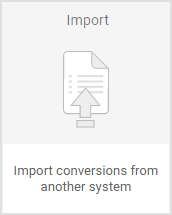
For other sources, it uses the click ID (GCLID) as primary key, which gives you the possibility to import offline sales back into AdWords. It requires some implementation and additional steps to set up, but it’s an absolute must-have. Not just for lead generators but for any advertiser who wants to incorporate what happens offline (like returns) into AdWords.
Measuring store visits and sales
If your website isn’t the only place where you sell your products or services, you have the additional challenge of measuring the impact of your online campaigns on the visits and sales in your physical stores or offices.
If you meet the requirements, AdWords can help you track the store visits and store sales that came after an interaction with your ads.
If you don’t meet these requirements, there are a few other ways to track the offline impact of your online advertising.
One of these ways is by using the Google Analytics Measurement Protocol. To get this working, check out Tom Capper’s Comprehensive Guide to Tracking Offline Interactions in Google Analytics using the Measurement Protocol.
And as always, Avinash Kaushik shares a great overview for measuring the offline impact of your online channels in Multichannel Analytics: Tracking Offline Conversions. 7 Best Practices, Bonus Tips. The 7 best practices mentioned are:
- Track your online store locator, directions, other direct offline dimensions. If you use location extensions, check the ‘Driving direction’ and ‘Get location details’ click types by segmenting by click type.
- Use unique 800 (toll free) numbers on the website.
- Use unique coupons, offers, promotions online.
- Marry / mine online and offline data.
- Leverage on-exit online surveys (or Point Of Sale surveys).
- Conduct controlled experiments.
- Primary research baby!
Tracking the offline impact of your online campaigns is probably one of the hardest things to do in online marketing, but hopefully you’re now better equipped to do so.
Not to forget, it works both ways: if you’re advertising on tv, radio, in newspapers or any other offline marketing channels, this also impacts your online results (especially direct traffic and searches for your brand), so you should also track the online impact of your offline campaigns.
Attribution Modeling
“The only use for last click attribution now is to get you fired. Avoid it.”
Avinash Kaushik
Apparently, this warning from 2013 didn’t prevent marketers to still massively use last-click (or first-click) attribution in 2017 (source: Econsultancy). And they probably even still have their jobs. It’s a shame.
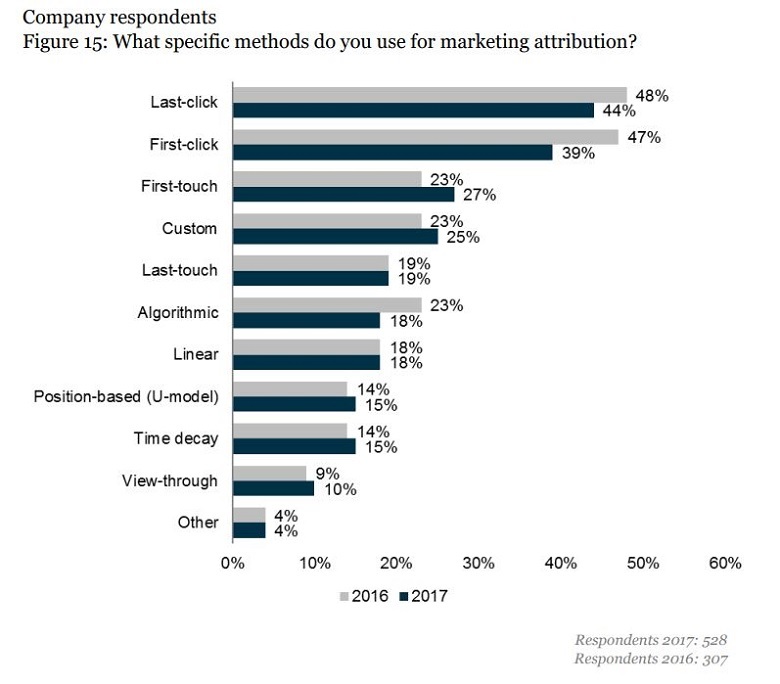
Within AdWords, you can easily change the default last-click model to a multi-touch model like linear, time decay, position based or data-driven (if you have enough conversions). Be sure to read Aaron Levy’s post What’s the best attribution model For PPC? to find out the pros and cons of each model. In short: anything is better than last or first click.
Once you’ve selected one of these models, you’ll see keywords having something like 2.5 conversions, which is exactly what you want: dividing the credit for generating conversions by multiple touchpoints within AdWords.
This doesn’t solve attribution across channels though, which becomes increasingly important as you use more (paid) channels to generate conversions on your website.
To get a quick feel for you ‘attribution problem’ you can take a look at the Multi-Channel Conversion Visualizer in Google Analytics. To see this go to: Conversions -> Multi-Channel Funnels -> Overview and select your most important (paid) traffic sources. If it looks like this:

You have less of an attribution problem compared to this situation:

Google Attribution is a product that can help you ‘solve’ your attribution problem. It has a free version, but it’s not available for everyone yet.
Tracking: Your Audit Checklist










